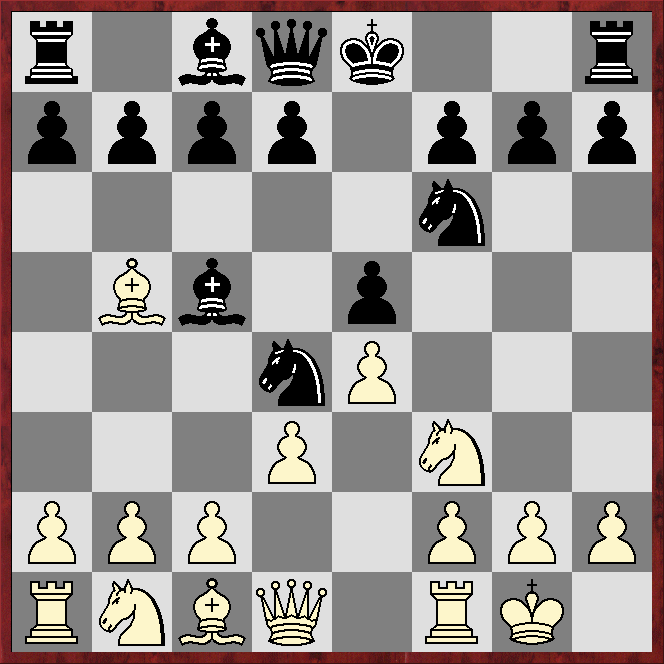The full game cane be seen at N1 but here I want to concentrate on an unusual twist that occurred in the opening, which was the Berlin Defence to the Spanish.
After 1.e4 e5 2.Nf3 Nc6 3.Bb5 Nf6 White chose the second-most popular continuation, 4.d3.
There are 12,479 examples of this move in ChessBase's 2022 Mega database, a long way behind the 26,976 examples of 4.0-0, which usually leads to the Berlin Wall after 4...Nxe4.
I replied 4...Bc5 and the game continued 5.0-0 Nd4 (5...d6 is the main move in Mega22).
*****
*****
*****
*****
Before this game I had reached the diagram position as black 11 times. The first nine featured 6.Nxd4, which is by far the most popular move in Mega22, but the last three, including this game, saw 6.Bc4!?
Stockfish15, but not Komodo13.02, marginally prefers Bc4, so what is the idea?
The first reasonably high-level game to feature the move was Heikki Westerinen - Dick van Geet, IBM B (Amsterdam) 1970.
It continued 6...d6 7.c3 Nxf3+ 8.Qxf3 Bg4 9.Qg3 and now White was rewarded when the dubious 9...Qd7?! was played.
The problem for Black is that 10.h3 cannot be met by 10...Bh5?? as two pieces are hanging after 11.Qxg7.
So Black played 10...h5!?, after which the engines disagree as to whether the black dark-square bishop can be captured.
Komodo13.02 reckons 11.hxg4 hxg4 12.b4 Bb6 13.a4 wins for White, but Stockfish15 continues 13...Nh5, claiming Black has the upper hand.
Perhaps understandably, Westerinen preferred 11.d4!?, which the engines agree gives White the upper hand.
The game continued 11...exd4 12.cxd4 Bxd4 13.Qd3 Bb6, after which White safely grabbed the bishop with 14.hxg4, giving White at least the upper hand, according to the engines (but ½–½, 36 moves).
Despite White's success in the opening, 6.Bc4!? did not attract much attention at high levels until the game Viktor Kupreichik (2505) - Yuri Malinin (2335), Chigorin Memorial (Saint Petersburg) 1998.
After 6...d6 the Belarusian grandmaster treated the position in Two Knights-style by playing 7.Ng5?!, presumably missing the effectiveness of 7...Bg4, when 8.Nxf7 loses to 8...Bxd1 9.Nxd8 Rxd8 10.Rxd1 Nxc2, and 8.Bxf7+ loses to 8...Ke7 9.Qd2 (or 9.Qe1) h6.
Kupreichik tried 8.Qd2 but 8....h6! 9.Nxf7 Qd7 leaves White unable to play 10.Nxh8 as 10...Nxf3+ 11.gxf3 Bxf3 leads to a quick mate for Black.
Instead the game saw 10.Kh1 Bf3! 11.Qe3 (11.gxf3 Nxf3 and ...Qh3) Ng4 12.Nxh8 - this is best, according to the engines, but after 12...Nxe3 13.fxe3 Bxg2+! 14.Kxg2 Qg4+ 15.Kh1 Nxc2 White could have resigned, although Kupreichik held out for another 21 moves.
Clearly Kupreichik's 7.Ng5?! cannot be recommended, but it does seem right for both players to treat the position in Italian Game-style.
The move ...d6 in reply to Bc4 is natural, but I preferred 6...Nxf3!?
This may seem strange at first as Black has spent three tempi with this knight only to exchange it in such a way that White gets to develop the queen for free with 7.Qxf3.
However things are not quite so simple in that White has also 'wasted' a tempo in taking two moves to put the light-square bishop on c4.
In addition Black has swopped the slightly passive queen's knight - it was defending e5 - for the slightly more active white king's knight - it was attacking e5.
Finally, the white queen is not necessarily well-placed on f3, where it blocks the white f pawn and will be shadowed by a black rook in the event of Black castling kingside.
One sign that Black may be on the right track is that the game has transposed to a position in Mega22 in which sometimes it is White to move.
I played 7...d6, and there followed 8.Nc3 c6.
*****
*****
*****
*****
Melikset Khachiyan (2480) - František Vrána (2250), Pardubice (Czechia) 1996, went 9.Be3 Bb6 10.h3 Be6 11.Rad1!? with an equal game, according to Stockfish15 and Komodo13.02 (but 1-0, 38 moves).
Veljko Draganić (2294) - Jiři Jirka (2415), MNT (Soznia, Montenegro) 2004, saw 9.a4 h6 10.Be3 Qe7 11.a5 0-0 12.Bxc5 dxc5 13.Qe3, when the engines reckon White may be slightly better (but 0-1, 37 moves).Melikset Khachiyan (2480) - František Vrána (2250), Pardubice (Czechia) 1996, went 9.Be3 Bb6 10.h3 Be6 11.Rad1!? with an equal game, according to Stockfish15 and Komodo13.02 (but 1-0, 38 moves).
Jörg Schmidt (2112) - Norbert Westphal (1965), World Seniors 50+ Team Championship (Dresden) 2016, continued 9.h3 Qe7 10.Bb3 Be6 11.Be3 Nd7!? 12.Ne2 0-0 with a roughly level game that was drawn in 33 moves.
My opponent played 9.h3, and I replied 9...a5, which gives the black dark-square bishop a retreat square at a7, gains space and threatens to win the white light-square bishop with ...b5 etc.
This was countered by 10.a4, after which 10...Be6 11.Be3 Bxe3 12.Qxe3 (12.fxe3?! Bxc4 13.dxc4) 0-0
gave a middlegame position the engines reckon is level.
However White has to be careful - the game saw 13.f4? exf4 14.Rxf4 Nh5 15.Rf2 d5 with advantage to Black.


No comments:
Post a Comment